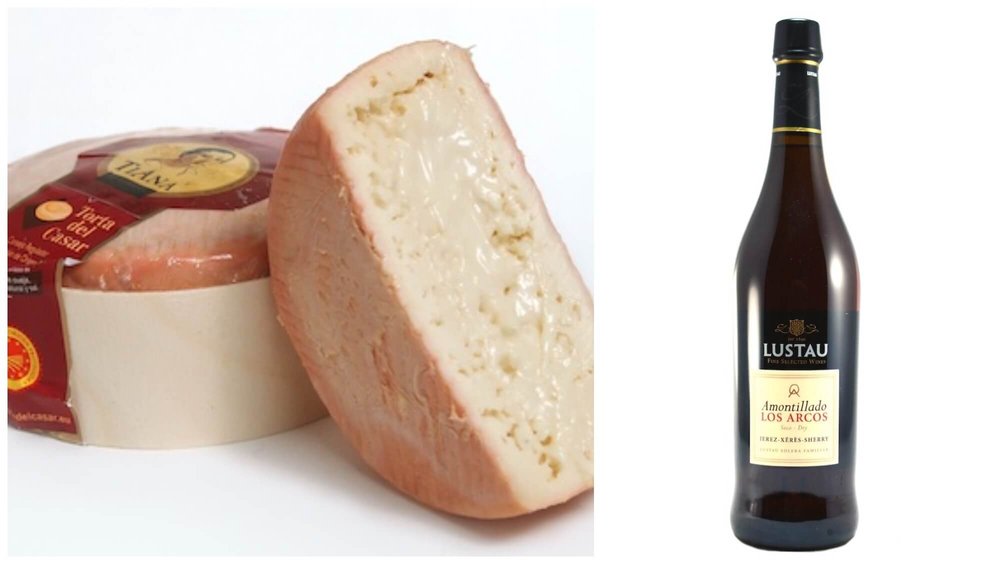Pairing wine and spirits with cheese gets tricky sometimes. The subtle complexities of flavor and aroma in cheese can get overwhelmed by the beverages we love on their own, or with our favorite meals. The expensive Burgundy you splurged on could bulldoze your cheese board and might best be saved for a roast duck dinner.
Recently, a few tots of sherry helped unlock some truly magical pairings, the type that cheese and booze enthusiasts crave. The magic happens when a pairing creates a sensation that is greater than the sum of its parts—the Bruno Mars + Cardi B moment in your mouth.
About Sherry

“Sherry is so fascinating,” and as wine topics go, “and really hard,” said guest taster Jessica McGlynn, a wine business manager at Breakthru Beverage an alcohol wholesaler. By definition, sherry is a fortified wine from the Jerez region of Southwestern Spain, near Cadiz, whose mild Mediterranean climate, hot summers, and coastal breezes provide the perfect setting for this unique product. Vinified from white grapes, mostly a grape called Palomino, the dry wines are fortified with wine-based alcohol (wine distillate), a practice developed to stabilize the wines for travel. Variations of this once common practice create classic beverages like Port and Cognac, and sherry goes through a unique aging process called the solera system, a dynamic method where the 600-liter American oak wine barrels or “butts” are strategically stacked in the bodegas and their contents are blended to create the various styles.
The wines can be either biologically aged (Finos and Manzanillas)—their surface in the butt protected by a flor or film of indigenous yeast that prevents oxidization, or oxidatively aged (Olorosos) which allows the air to create an oxidized flavor. Sherries may be sold at an average age of two years, but because of the fractional blending, each barrel may contain wine of many vintages.
Styles of Sherry & Cheese
McGlynn and I sat down with four styles of sherry and six cheeses: a French Brie de Nangis, Queen of Corona (an aged goat from Toledo Spain finished by Crown Finish Caves in Brooklyn), an alpage (from high Alpine meadows) Gruyère, Shooting Star’s Aries (a California aged sheep), an aged gouda, and a classic raw sheep milk Roquefort.

Manzanilla
The pale, crisp, saline Manzanilla was delightful with the aged garrotxa-like goat, but the aged sheep cheese in the line-up brought out a very pleasantly perfumed floral note in the wine. Manzanilla pairs well with a diverse range of more nuanced cheeses and forms a classic pairing with raw seafood.

Oloroso
The Oloroso showed nutty and olive-y, and definitively not sweet. Surprisingly, the creamy earthiness of the French cow brie coaxed out a brandied note in the sherry that was truly excellent. This wine would be outstanding with a plate of Spanish ham and younger cheeses. A versatile style of sherry, El Consejo Regulador de vinos de Jerez y Manzanilla (Consejo Regulador) also notes that Parmigiano Reggiano, very mature manchego, mature Cheddar, and medium strength blues such as gorgonzola also pair well with oloroso.

Pedro Ximenez
Pedro Ximenez sherry is made from intentionally overripe grapes, dried in the sun like raisins. The dark, almost opaque PX tastes velvety, toasty and honeyed, and makes a classic pairing with rich salty sheep blues like the Roquefort. The pairing made the cheese zingier and the wine less cloying. Said McGlynn, “Up against a tangy cheese like the aged goat, the sherry tastes like syrup. But the salt and cream in the Roquefort let’s you taste the acid in the wine.” When we tasted the PX with the alpage Gruyère, we got a delightful surprise. The grassiness of the cheese sang—the flavors joined in a green, celery leaf sonata. Pedro Ximenez, the cheese-friendliest of the bunch, would pair with aged, salty, and bold cows and sheep.
The Consejo Regulador also recommends pairing Pedro Ximenez with Roquefort or Stilton.

Cream
Less surprisingly, the sweet, somewhat ordinary Bristol Cream Sherry played well with the aged gouda. “It’s matchy matchy, but not magic,” mused McGlynn, but she agreed that the classic caramelized flavors of the cheese brought out nice maple notes in the sherry. This ordinary wine would be just fine with most ordinary cheese, especially as a dessert course. Cream sherries are traditional favorites in Britain, blended from wines made from the dry Palomino grapes, plus sweeter wines from Moscatel and PX grapes, and sometimes with added grape syrup to create the flavor profile that pleases their fans. The Consejo Regulador recommends pairing it with hard such as Parmigiano Reggiano and Gouda.

Fino
The Consejo Regulador recommends pairing fino with young manchego, mild to medium Cheddar and Cheshire. Other sources also recommend pairing it with Feta.

Amontillado
The Consejo Regulador recommends pairing with brie, Caerphilly, soft gooey goat’s cheese, or Torta del Casar, a ewe’s milk cheese from but also points out that truffled cheeses and smoked cheeses pair well too. Other sources suggest pairing it with aged Comté.
Because sherries are fortified, you can keep an uncorked bottle anywhere from a week to a few months depending upon the style, and they are also fantastic wines to cook with. Pop a couple of varieties with your next cheese board and keep them around to create future magic.
